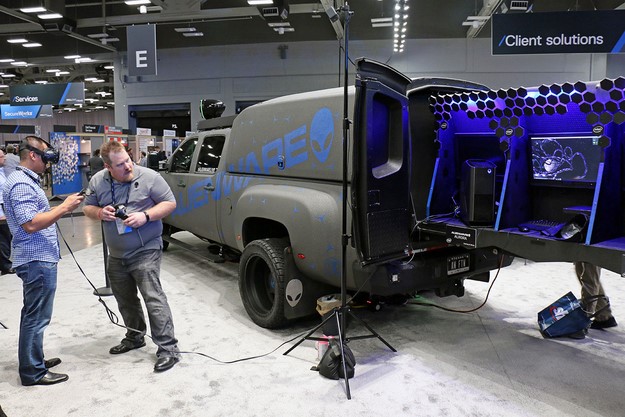Dell has been active in both esports and virtual reality, as both of these sectors are helping drive sales of high-end gaming PCs under the Dell and Alienware brands. Additionally, a third PC pillar that Dell is investing in is drone racing, which also appeals to the esports fans and many VR early adopters.
Josh Bernstein, vice president of technology for Dell EMC, ensured that Alienware and Dell PCs featuring VR games across Oculus Rift and HTC Vive were on display at the recent Dell EMC World conference at The Sands in Las Vegas. Esports was also part of the equation with 2K’s NBA 2K17 playable on PC. He sees crossover with drones, VR and esports moving forward. He talks to AListDaily about the opportunities these sectors open up for millennials in this exclusive interview.

Dell and its Alienware brand have been involved with esports for several years now. Are there similarities when you look at the future of DR1 Racing with drones and what’s happened with professional video gaming?
Absolutely, and with drone racing there’s a real crossover. Historically with esports, it’s all based around point-and-click games. They can be very hard to follow, but this idea of mixing simulators in with real flight physics and being able to crossover from playing a video game to actually flying a drone is unique. You don’t really see that in esports. If you look at Rocket League, nobody is going to be able to drive a Rocket League car in real life all of a sudden, but certainly with drone racing that’s not necessarily true, and that makes the drone crossover really unique. Alienware, being the leading esports video game machine provider, is a great fit for that, so we’re happy to have Alienware here. We’re happy to have DR1 Racing here, and it’s been great all-around.
What impact is the new generation of kids having on racing leagues?
What’s interesting about this is that it is one of those sports that gets the younger generation outside. My two-year-old doesn’t understand watching live TV. When a commercial comes on he gets very upset. They don’t understand this. But we grew up watching cartoons with commercials and playing outside. With drone racing, they can play a video game inside and then go outside and race a drone with other human beings. It’s truly unique and different from what’s going on in other areas of the culture around us.
Alienware has put a lot of emphasis on virtual reality. What are your thoughts on where the industry is headed?
When I first saw the Alienware HTC Vive systems and did that room-scale immersive VR experience, it was mind-blowing. It really is unbelievably immersive. You feel like you’re there, and if you want to play basketball or shoot bows and arrows, you feel like you’re there. We’ve tried VR in the ‘90s and dabbled in it for a little while with these headsets that were way too big. The resolutions were small and we couldn’t wear glasses inside of them. But now the experience is so immersive, and Alienware can provide it at a price point so that anybody can consume it in their living room. It’s just unbelievable.
How do you see VR and drone racing intertwining?
Specifically, with drone racing, you could have consumers of the content sitting at home with VR goggles watching the race and watching the drones zip around them. Instead of standing and watching it on TV they can cast themselves in the experience and stand on the gate that the drones are racing through and really feel immersed in it. VR has made this experience consumable for the general masses, but also to make it consumable from a different perspective.
If you’ve seen what some of these other companies have done with watching basketball games in VR like you’re on the court, or you’re standing looking over the shoulder on the pitcher’s mound, it’s an unbelievable experience. It provides an emotion that I think just watching TV or playing a video game in front of the screen can’t offer.
How do you see things like DR1 Racing helping to get the Dell and Alienware brands out there to the younger demographic?
It’s all about brand awareness. If Alienware can participate with DR1, DR1 can participate with Alienware. The goal is to provide the best possible experience. If you want to do drone racing on your Alienware laptop, we can work with DR1 to co-develop a simulator to work on the physics engines and things like that. The Alienware experience should be the best experience of that simulation of that race. I look forward to working with DR1 on it and it’s going to be a ton of fun.
We’ve seen the Intel Extreme Masters esports tournament experiment with virtual reality. Do you see a lot of potential in bringing together VR with esports?
It just adds a whole new dynamic to it. It’s one thing to sit at a keyboard and point-and-click, and it’s another thing to have to physically interact with the environment. It adds a whole new dimensionality to esports. People balked at first when calling esports a sport because there wasn’t a physical challenge involved. It was all very mental and there was a lot of practice and a lot of knowledge of the rules. So, to add another dimension to it is really incredible.
Next year we’re going to see the NBA enter esports with the NBA 2K Eleague. We already saw the NFL enter this year with Madden. What does that say when you have actual established sports league entering the video game esports space?
It legitimizes the space, but it’s also proof that as these older brands like the NFL and the NBA want to reach out to a younger audience. They’re appealing to where these viewers are going: into video games. If I can create an allegiance to a team because I’ve played them to a national championship in a video game, it serves both parties. It really is a way to engage and make accessible content to younger audiences. It’s absolutely brilliant for both the NBA and the NFL to go out and do this and I hope that we see other large sports franchises do exactly the same thing.

